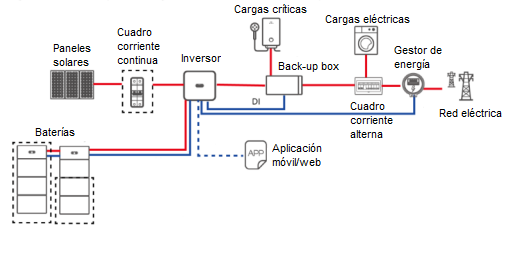Photovoltaic Installation Guide
Types
A photovoltaic installation is an energy capture system designed to supply electricity through solar energy. As the energy comes from the sun, an inexhaustible source of supply, the electricity generated is renewable and environmentally-friendly.
1. Grid-connected photovoltaic power system
It is the most usual case, over 90% of the installations we do. The property where the solar panels are installed is already connected to the utility grid.
Its operation is very simple, during the sun hours, when the panels produce energy, the electrical consumption is taken from the photovoltaic installation. When they are not producing enough energy, the electricity will come either the solar panels and the utility grid. Otherwise, when there is no sun, the energy will be completely used from the utility grid. In the event of a power cut, the photovoltaic installation stops producing energy because, being connected to the grid, it needs it for its operation.

1.1. Installation feeds excess power to the grid
The photovoltaic installation produces 100% of what it can produce at all times and the surplus that the user does not consume is sold to the local grid energy company.
1.2. Installation without surplus compensation
The installation produces only what the user needs (as long as there is enough sun).
2. Isolated photovoltaic installation
The installation is not connected to the utility grid, and, therefore, it does not need it to work. In this case, the user will only be able to use electricity when the photovoltaic installation is producing energy, (with the exception of the installation with batteries, if batteries have
stored energy, the user will be able to use it until it runs out). As it is not connected to the utility grid, in this modality it is not possible to discharge and compensate the surplus produced by the installation.
Components
Solar cells:
Devices that capture electrical energy from the sun. They can be monocrystalline, polycrystalline or thin-film. We install the monocrystalline type because of its efficiency and its quality/price ratio. Depending on the power of the chosen panels and the manufacturer, their dimensions will be larger or smaller.
Structures:
Supports where the solar panels will be anchored and screwed. Depending on the surface where they will be installed, we will choose inclined or coplanar structures.
Inverter:
Device that changes direct current from de cell panels to alternating current, which is the one used in homes, industries, etc.
Smart meter:
Electronic device that, depending on the user's consumption needs at all times, regulates the electricity that the photovoltaic installation needs to generate and, if it is not enough, extracts the rest of the electricity supply from the utility grid.
Direct current supply box:
Electrical box where the direct current protections of the installation are installed.
Alternating current supply box:
Electrical box where the alternating current protections of the installation are installed.
Visualization application:
Mobile and web application to visualize the electricity consumption and production of the photovoltaic installation so the user can manage energy more efficiently.
Battery:
Device where the energy generated by the installation is accumulated and has not been consumed at the time of generation. This energy will be used when the photovoltaic installation cannot generate everything the user needs. It is an optional component of the installation and usually makes it quite expensive, however, there are also subsidies to be able to install them.
Back-up box:
Device that is installed only in case of having installed battery. It is responsible for supplying current to a series of loads that are considered and configured as critical to guarantee their operation in the event of power outages.
Electrical wiring:
Specific and special wires that are used for each part of the installation (direct current, alternating current and data)
Optimizers:
Devices that are installed (optionally) on the solar panels that are shaded, at some time of the day, to prevent the reduction of the installation performance.
Process
- 1.Request for a quote.
- 2. Preliminary site visit.
- 3. Quote acceptance.
- 4. Preparation of the technical design report (for installations with power ≤ 10kW) or technical project (for installations with power > 10kW).
- 5. Execution of the photovoltaic installation.
- 6. Legalization of the installation.
- 7. Procedures with the distributor (only for installations on rural land and for those greater than 10kW).
- 8. In the case of grid-connected installations with surplus injection, the client can update their current contract with the energy supplier for the sale of the surplus. Once accepted, the client will call the installer to reconfigure the inverter and start injecting the surplus into the grid.

Why Alcasur?
Because of our differentiating core VALUES
Service
We will guide you with complete transparency at no additional cost, from the initial quote request until the installation is complete.
Customer, our priority
We adapt to all your needs to offer you a solution that suits you.
Quality guarantee
In all our installations we use quality materials, that is the reason why we offer guarantees on all our services and installed products.
Documentation
We take care of all our installations documentation to make it easier for you.
